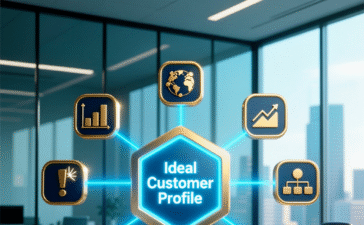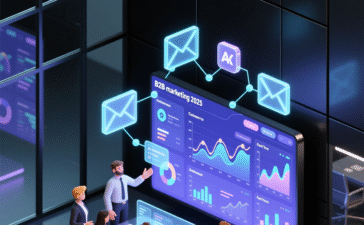Check out all LinkedIn processes, updates, rankings, how it works, and 13 expert tips for promoting LinkedIn in 2024 in this comprehensive guide.
With a user base of 1 billion, LinkedIn continues to be a powerful driver of personal and professional development.
LinkedIn expert Neil Patel once said: “LinkedIn is no longer an online resume. It’s your digital reputation.” It is the go-to platform for building meaningful connections, sharing valuable insights, and positioning yourself as a thought leader in the industry.
The ultimate transition of this job-seeking platform into your professional portfolio can be seen with the evolution of LinkedIn algorithm over time.
Do you know how the LinkedIn algorithm determines the quality of content in your feed? Recent studies show that the organic reach of your post among your connections is only 1%.
If you want great ideas to beat the genius LinkedIn algorithm, this blog is for you. Ranging from basic intricacies to expert tips and tricks, there is everything you need.
So, let’s dive in.
What Is LinkedIn Algorithm?
The LinkedIn algorithm is a supersmart filter ensuring that only the most relevant, personalized, and interesting content reaches your feed.
This formula filters content based on your connections, interests, relevance, and engagement, bringing you the most informative and interesting newsfeed.
One of the things that keeps us glued to social media for hours is how personal social media is. Nobody likes to come across irrelevant content.
As more and more people are posting, there is a need for a clever assistant to make sure only the content that matters goes viral. According to the LinkedIn Algorithm 2023 Update, this is a platform where people look for information and updates rather than going viral.
LinkedIn Algorithm Updates 2023
In June 2023, LinkedIn announced an updated algorithm based on user feedback and suggestions. The LinkedIn algorithm will change in 2023 to improve user experience and make it more relevant and engaging.
To prevent the spread of irrelevant content, LinkedIn has improved its algorithm to adapt to the B2B social environment. As a result, the platform aligns well with its niche audience.
Here’s what has changed:
1. Promoting Knowledge and Advice
According to LinkedIn’s latest updates, posts that share information and advice are more likely to be promoted on the platform. LinkedIn has seen a 40% increase in people viewing posts sharing expertise and advice.
2. Strengthening Connections
After the 2023 LinkedIn algorithm change, your followers will be more likely to see your posts. So, you will see the posts of the people you follow. LinkedIn saw a 10% increase in the number of people viewing their followers’ posts.
Core Takeaways: LinkedIn wants you to stay focused and create content for your niche, making it informative and relevant. So, sharing relevant educational insights will benefit more than covering every trending topic on the platform.
What Are LinkedIn’s Ranking Signals?
These LinkedIn ranking indicators are the main criteria the algorithm uses to further deliver your content to users. The most important signs are the connection between the individual, the truth and the ability to cooperate.
It is because every year, 443 billion posts are shared on LinkedIn, and they need to be filtered out by the algorithm and delivered to user’s feeds per their interests.
1. Connection
To foster connections between users, LinkedIn shares your content primarily with people who have a strong relationship with you. This sharing starts with your direct connections and gets your content visible in their place.
Once your direct connection’s view and engage with your content, the algorithm works towards sharing it with 2nd-level and 3rd-level connections.
The chart below shows how your second- and third-level contacts view your content in their feeds.
2. Relevance
Accuracy is the most important signal when the LinkedIn algorithm filters content. Every social media algorithm prioritizes what’s important.
Matches your content according to your target audience’s interests, professions and industries. This is done through the pages, accounts, groups they follow, as well as the content and hashtags they share.
It also tracks people who interact with you and shows you details of their posts. To grow your audience, you need to network with people outside of your industry and niche.
3. Engagement
After getting filtered based on connections and relevance, engagement is the next ranking signal that determines further content visibility.
The higher the likes, comments and shares, the higher the engagement and content likes. That’s why the algorithm favors content that encourages discussion, dissent, and interaction.
But LinkedIn’s “engagement” signal is slowly disappearing with each algorithm update. After being the highest organic reach-generating social media platform, LinkedIn now wants to strengthen the algorithm for paid ads and sponsored content, just like the Facebook algorithm.
Therefore, focus on building strong connections, creating relevant content, and promoting engagement to get desired visibility.
Understanding and optimizing your content as per these ranking signals will help increase your LinkedIn presence.
How Does the LinkedIn Algorithm Work? Even if you know what will make your content perform well, you need to know how these indicators affect the LinkedIn algorithm’s decision-making process.
How your content passes through different algorithmic filters determines the strength of your ranking potential. Let’s see how your content proves its value at each stage of the algorithm mechanics:
1. Filtering: Checking Spam or Clear Content
The first step of the algorithm is to check whether your content is suitable for LinkedIn. Based on its community guidelines or quality your content is divided into three major categories based on its community guidelines or quality.
- Spam Content
- Low-Quality Content
- High-Quality Content
If your content is detected as spam, it may get removed, or the LinkedIn algorithm will limit its distribution. Low-level content will also get less traction; only high-quality content will reach virality.
2. Testing: Sending Your Content for Testing
If your content passes the harsh quality control stage, it will be moved to the testing stage.
The LinkedIn algorithm will begin showing content to various levels of your contacts and tracking engagement indicators. This is a time when humans test your content for authenticity.
3. Delivering: Dispatching Content to Relevant Users
When your post is relevant and generates high engagement, the LinkedIn algorithm distributes it to a wider audience.
Since virality is not a key part of the algorithm, you must focus on creative, informative and niche content to meet this standard.
The LinkedIn algorithm will not forward your messages to irrelevant users. It shares it further with those more likely to like and engage with it.
The latest LinkedIn algorithm update will allow you to attend to more people’s problems. But it also makes it harder to break the rules and get more involved than ever.
13 Ideas for Introducing the LinkedIn Algorithm in 2024
Three million users post on LinkedIn every week, but only a select few benefit from high engagement. This is because they are not familiar with the smart ways to outsmart LinkedIn algorithms and acquire the position of high-quality trending content.
There are several other factors you can track down to protect your post from getting spam and have it distinguished as high-quality content.
We offer important tips to help you avoid this mistake.
1. Optimize Your Profile
The first step is to edit the source of all your content: your profile.
Make your profile shine like a jewel by adding all the necessary information, e.g.
- A Clear Profile Picture
- An Engaging Headline
- A Detailed Summary
- Add from the 41k Skills available on LinkedIn
Most importantly, make sure your profile is complete and professional to attract real interest. Recent studies show that the LinkedIn algorithm Favor’s accounts with complete and updated information and gains 40 times more opportunities.
2. Be Informative and Relevant to Your Niche
All we have talked about till now is the importance of relevance in the LinkedIn algorithm. To overcome this algorithmic process, you need to create informative and interesting content.
You already know how much the LinkedIn algorithm loves knowledge and information, so you may want to include this in your message to rank higher.
This way, the tailor-made wisdom you share with your audience will make you a guru in your niche.
3. Post When Your Followers Are Online
You usually know what you want to publish, but you barely know “when?” There must have been a post, perfect in all senses, but it still didn’t get the expected traction. This is because you are following old version standards. You need to know the best time to post on LinkedIn.
4. Follow a Consistent Posting Schedule
Based on the LinkedIn algorithm, we found that businesses that publish weekly content see a 2x increase in engagement. That’s why it’s important to follow LinkedIn.
This will help you keep your audience hooked and make them anticipate your next content update. It will also show that you are committed to sharing important content.
When the LinkedIn algorithm evaluates your compatibility, it creates a more harmonious relationship for you by sending your content to a wider audience.
5. Don’t Edit Your Post After Publishing
If you edit your post after publishing, you should know that editing your post within the first 10 minutes will reduce your views from 10% to 40%.
You must keep your hands off after posting the content during the golden hours (first few hours after posting) on LinkedIn because if you don’t, it will disrupt the post-performance and algorithm evaluation process.
If you find an error in the content of an ad, instead of editing the original text, please copy the text, delete the original text, make the necessary changes and resubmit.
6. Post Different Formats
Distributing your content by mixing different media types will create different interests and increase engagement.
Some of the post types that see the highest traction on LinkedIn are videos, pictures, and question-based posts.
Did you know that video posts get the highest engagement on LinkedIn? A video is 20x more likely to be re-shared by users, and an image post receives 2x higher engagement.
7. Don’t be the first to comment on your LinkedIn posts
Don’t comment on your own comments, make sure your visitors see your comments first. Once your audience has left some thoughts, you can leave a comment.
Commenting on your first post breaks the LinkedIn algorithm and reduces the effectiveness of your post. It can also affect the performance of your message when it matters most—the time period that matters.
When you use our tool to schedule an ad on LinkedIn and add a comment during scheduling, the ad is delivered at the same time as the ad so it does not interfere with the ad’s algorithm that runs later.
8. Promote Your Posts
Spread your message as widely as possible within your network to achieve greater reach.
Tagging people is a way to promote your posts, but don’t tag anyone. Within an hour, only people you know will interact with your message.
This is one way to expand your reach on LinkedIn, but you can opt for other platforms to beat the algorithm. Share your LinkedIn post across other social media channels and relevant groups.
9. Use Relevant Hashtags
Targeted use of hashtags is the best way to promote your message and beat the LinkedIn algorithm.
Hashtags can increase discoverability and connect with user’s interest in similar topics and industries.
Use only 3 – 5 hashtags. One should be broad, the other should be about niche content, and the other can be specific and create a funnel.
10. Stop Using External Links
Adding external links to your LinkedIn post is the worst promotional practice ever.
Adding links to your posts can reduce the number of views your posts receive by approximately 50%. Posts with external links have the lowest engagement rate on LinkedIn.
Do not add a link to the content of the post, add it to the comments after a few hours. This is a smart way to easily connect and beat the LinkedIn algorithm.
11. Take Optimum Gaps Between Two Posts
According to a recent report, you should wait at least 10-12 hours after sharing an ad before sharing another ad.
This is advised because if one of your posts is doing well and getting good engagement, let that post grow. You can share your next article after your previous article service stops.
Don’t bombard your audience with back-to-back posts; give them breathing room. Sharing consecutive posts can disrupt the algorithm and reduce the reach of high-performing posts.
12. Follow Regular Engagement Practice
To get good results, you need to strengthen the integration of signals when sharing.
The LinkedIn algorithm tracks your interaction and then shares your message with a wider audience. It is recommended to follow the application regularly to achieve greater effect.
To beat the algorithm, you must engage with messages from other accounts approximately 30 minutes before and 30 minutes after sharing the post. This approach can increase your leads by up to 30%.
13. Find Your LinkedIn SSI Score
SSI stands for Social Selling Index and determines your ranking on the platform.
A good SSI Score is considered to be above 70%, which can get you a 20% to 25% boost in your reach.
This is a score that reflects your personal brand and your ability to generate leads and convert them into sales.
We’ve put together some tips and tricks to help you grow on LinkedIn and build an environmental algorithm in your favor.
99% of LinkedIn users don’t know these LinkedIn algorithm-beating tips. So, use them and expand your reach and engagement beyond expectations.
Final Words
As we discovered, the LinkedIn algorithm is responsible for content analysis and classification, deciding what users will see. Chapter However, this algorithm is not static and will change over time. To adapt to the LinkedIn algorithm update in 2024 and beat the algorithm, here are 13 proven effective strategies.




